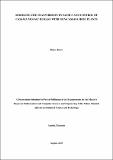| dc.description.abstract | For many years cassava mosaic disease hinders cassava production in Africa. In this study,
the mathematical model for the transmission dynamics and control of cassava mosaic disease
in cassava and non-cassava host plant populations was formulated and analysed. The next generation matrix technique was employed to obtain the basic reproduction number (R0). The
local stability of the disease-free equilibrium point was determined using the Linearization
method while the normalized forward sensitivity index technique was utilized to analyse the
sensitivity of the model parameters. The optimality control technique, based on the Pontraygin
Maximum Principle, with roguing activities and insecticide application as control strategies,
has been applied to achieve the optimality of objective function. Moreover, the Incremental
Cost-effectiveness Ratio approach was used to perform a cost-effectiveness analysis on control
strategies in combating cassava mosaic disease. Lastly, the numerical simulation for the formu lated models to assess sensitive parameters, global stability and the optimal solution was per formed. The findings reveal the existence and global stability of both disease-free and endemic
equilibrium points when R0 ≤ 1 and R0 > 1 respectively. The most sensitive parameters
for the dynamics of cassava mosaic disease were found to be whitefly mortality rate (ω) and
the whitefly carrying capacity per m2
(κw). The findings from numerical simulation and cost effectiveness analysis on the optimality system conclude that the combined method of roguing
and insecticide application has higher impacts with a lower cost of controlling the disease com pared to the single control approach of roguing activities or insecticide application. Therefore,
for effective and efficient mitigation of cassava mosaic disease, results from this study suggest
the integrated approach of roguing and insecticides application | en_US |

